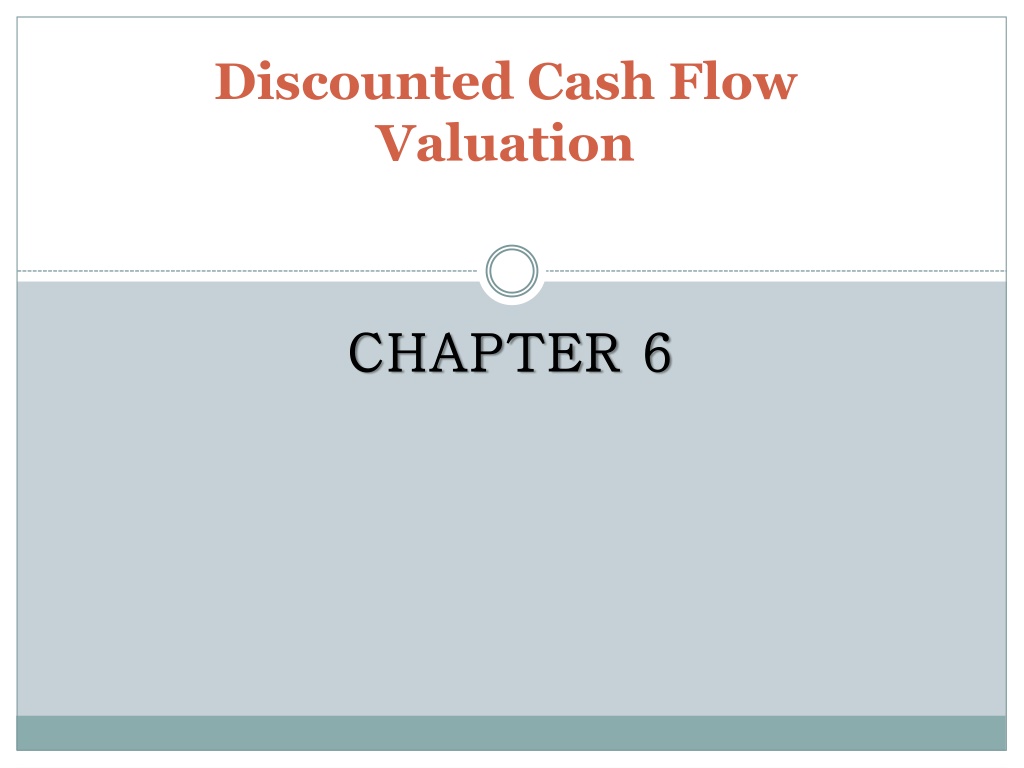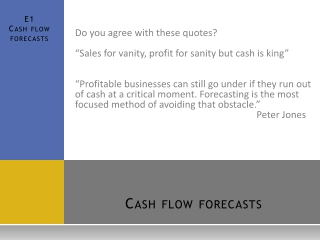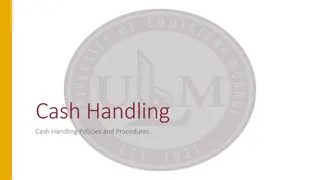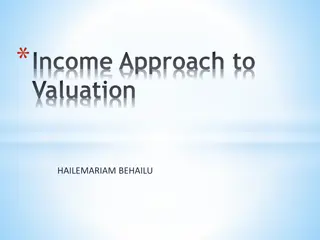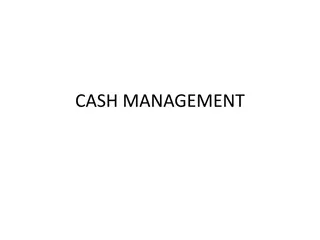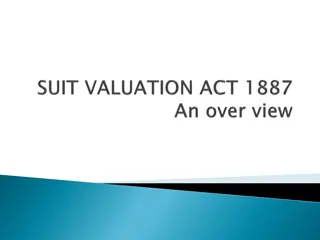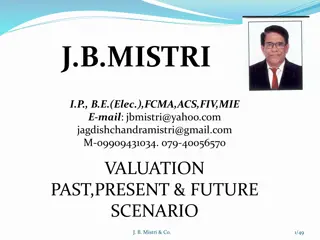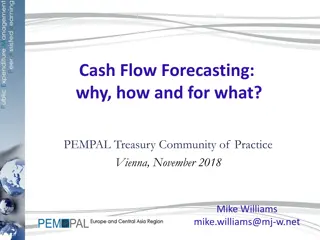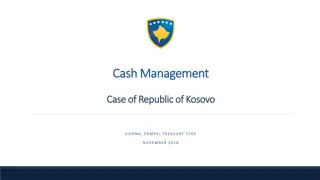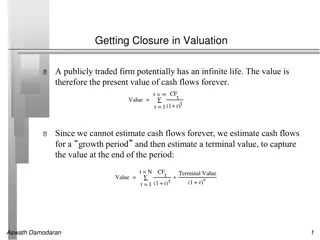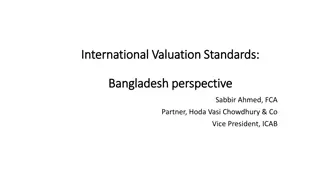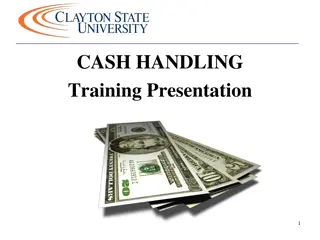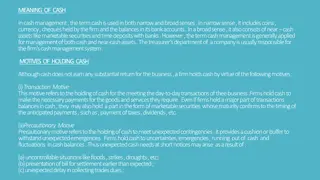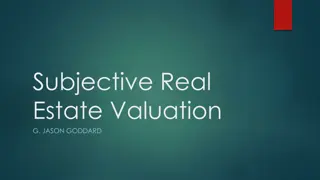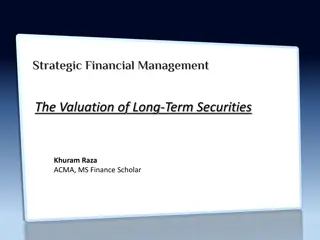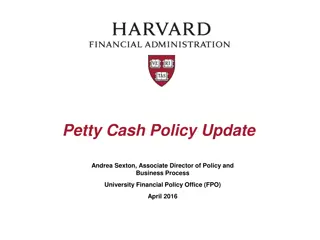Understanding Discounted Cash Flow Valuation in Finance
Learn key concepts and skills related to discounted cash flow valuation, including computing future and present values of multiple cash flows, understanding loan payments and interest rates, and how loans are amortized. Explore examples of calculating future values of multiple cash flows and determining present values.
Download Presentation

Please find below an Image/Link to download the presentation.
The content on the website is provided AS IS for your information and personal use only. It may not be sold, licensed, or shared on other websites without obtaining consent from the author. Download presentation by click this link. If you encounter any issues during the download, it is possible that the publisher has removed the file from their server.
E N D
Presentation Transcript
Discounted Cash Flow Valuation CHAPTER CHAPTER 6 6
Key Concepts and Skills Be able to compute the future value of multiple cash flows Be able to compute the present value of multiple cash flows Be able to compute loan payments Be able to find the interest rate on a loan Understand how interest rates are quoted Understand how loans are amortized or paid off
Chapter Outline Future and Present Values of Multiple Cash Flows Valuing Level Cash Flows: Annuities and Perpetuities Comparing Rates: The Effect of Compounding Loan Types and Loan Amortization
Multiple Cash Flows Future Value Example 6.1 Find the value at year 3 of each cash flow and add them together. Today (year 0): FV = 7000(1.08)3= 8,817.98 Year 1: FV = 4,000(1.08)2= 4,665.60 Year 2: FV = 4,000(1.08) = 4,320 Year 3: value = 4,000 Total value in 3 years = 8,817.98 + 4,665.60 + 4,320 + 4,000 = 21,803.58 Value at year 4 = 21,803.58(1.08) = 23,547.87
Multiple Cash Flows FV Example 2 Suppose you invest $500 in a mutual fund today and $600 in one year. If the fund pays 9% annually, how much will you have in two years? FV = 500(1.09)2+ 600(1.09) = 1,248.05
Multiple Cash Flows Example 2 Continued How much will you have in 5 years if you make no further deposits? First way: FV = 500(1.09)5+ 600(1.09)4= 1,616.26 Second way use value at year 2: FV = 1,248.05(1.09)3= 1,616.26
Multiple Cash Flows FV Example 3 Suppose you plan to deposit $100 into an account in one year and $300 into the account in three years. How much will be in the account in five years if the interest rate is 8%? FV = 100(1.08)4+ 300(1.08)2= 136.05 + 349.92 = 485.97
Multiple Cash Flows Present Value Example 6.3 Find the PV of each cash flows and add them Year 1 CF: 200 / (1.12)1= 178.57 Year 2 CF: 400 / (1.12)2= 318.88 Year 3 CF: 600 / (1.12)3= 427.07 Year 4 CF: 800 / (1.12)4= 508.41 Total PV = 178.57 + 318.88 + 427.07 + 508.41 = 1,432.93
Example 6.3 Timeline 0 1 2 3 4 200 400 600 800 178.57 318.88 427.07 508.41 1,432.93
Multiple Cash Flows PV Another Example You are considering an investment that will pay you $1,000 in one year, $2,000 in two years and $3000 in three years. If you want to earn 10% on your money, how much would you be willing to pay? PV = 1000 / (1.1)1= 909.09 PV = 2000 / (1.1)2= 1,652.89 PV = 3000 / (1.1)3= 2,253.94 PV = 909.09 + 1,652.89 + 2,253.94 = 4,815.92
Quick Quiz Part I Suppose you are looking at the following possible cash flows: Year 1 CF = $100; Years 2 and 3 CFs = $200; Years 4 and 5 CFs = $300. The required discount rate is 7% What is the value of the cash flows at year 5? What is the value of the cash flows today? What is the value of the cash flows at year 3?
Annuities and Perpetuities Defined Annuity finite series of equal payments that occur at regular intervals If the first payment occurs at the end of the period, it is called an ordinary annuity If the first payment occurs at the beginning of the period, it is called an annuity due Perpetuity infinite series of equal payments
Annuities and Perpetuities Basic Formulas Perpetuity: PV = C / r Annuities: 1 1 + t ( 1 ) r = PV C r + t ( 1 ) 1 r = FV C r
Annuity Example 6.5 You borrow money TODAY so you need to compute the present value. 48 N; 1 I/Y; -632 PMT; CPT PV = 23,999.54 ($24,000) Formula: 1 1 48 . 1 ( 01 ) = = 632 23 999 , 54 . PV 01 .
Annuity Sweepstakes Example Suppose you win the Publishers Clearinghouse $10 million sweepstakes. The money is paid in equal annual installments of $333,333.33 over 30 years. If the appropriate discount rate is 5%, how much is the sweepstakes actually worth today? PV = 333,333.33[1 1/1.0530] / .05 = 5,124,150.29
Buying a House You are ready to buy a house and you have $20,000 for a down payment and closing costs. Closing costs are estimated to be 4% of the loan value. You have an annual salary of $36,000 and the bank is willing to allow your monthly mortgage payment to be equal to 28% of your monthly income. The interest rate on the loan is 6% per year with monthly compounding (.5% per month) for a 30-year fixed rate loan. How much money will the bank loan you? How much can you offer for the house?
Buying a House - Continued Bank loan Monthly income = 36,000 / 12 = 3,000 Maximum payment = .28(3,000) = 840 PV = 840[1 1/1.005360] / .005 = 140,105 Total Price Closing costs = .04(140,105) = 5,604 Down payment = 20,000 5604 = 14,396 Total Price = 140,105 + 14,396 = 154,501
Quick Quiz Part II You know the payment amount for a loan and you want to know how much was borrowed. Do you compute a present value or a future value? You want to receive 5,000 per month in retirement. If you can earn .75% per month and you expect to need the income for 25 years, how much do you need to have in your account at retirement?
Finding the Payment Suppose you want to borrow $20,000 for a new car. You can borrow at 8% per year, compounded monthly (8/12 = .66667% per month). If you take a 4 year loan, what is your monthly payment? 20,000 = C[1 1 / 1.006666748] / .0066667 C = 488.26
Finding the Number of Payments Example 6.6 Start with the equation and remember your logs. 1,000 = 20(1 1/1.015t) / .015 .75 = 1 1 / 1.015t 1 / 1.015t= .25 1 / .25 = 1.015t t = ln(1/.25) / ln(1.015) = 93.111 months = 7.76 years And this is only if you don t charge anything more on the card!
Finding the Number of Payments Another Example Suppose you borrow $2,000 at 5% and you are going to make annual payments of $734.42. How long before you pay off the loan? 2,000 = 734.42(1 1/1.05t) / .05 .136161869 = 1 1/1.05t 1/1.05t= .863838131 1.157624287 = 1.05t t = ln(1.157624287) / ln(1.05) = 3 years
Finding the Rate Suppose you borrow $10,000 from your parents to buy a car. You agree to pay $207.58 per month for 60 months. What is the monthly interest rate? Sign convention matters!!! 60 N 10,000 PV -207.58 PMT CPT I/Y = .75%
Quick Quiz Part III You want to receive $5,000 per month for the next 5 years. How much would you need to deposit today if you can earn .75% per month? What monthly rate would you need to earn if you only have $200,000 to deposit? Suppose you have $200,000 to deposit and can earn .75% per month. How many months could you receive the $5,000 payment? How much could you receive every month for 5 years?
Future Values for Annuities Suppose you begin saving for your retirement by depositing $2,000 per year in an IRA. If the interest rate is 7.5%, how much will you have in 40 years? FV = 2,000(1.07540 1)/.075 = 454,513.04
Annuity Due You are saving for a new house and you put $10,000 per year in an account paying 8%. The first payment is made today. How much will you have at the end of 3 years? FV = 10,000[(1.083 1) / .08](1.08) = 35,061.12
Annuity Due Timeline 0 1 2 3 10000 10000 10000 32,464
Perpetuity Example 6.7 Perpetuity formula: PV = C / r Current required return: 40 = 1 / r r = .025 or 2.5% per quarter Dividend for new preferred: 100 = C / .025 C = 2.50 per quarter
Quick Quiz Part IV You want to have $1 million to use for retirement in 35 years. If you can earn 1% per month, how much do you need to deposit on a monthly basis if the first payment is made in one month? What if the first payment is made today? You are considering preferred stock that pays a quarterly dividend of $1.50. If your desired return is 3% per quarter, how much would you be willing to pay?
Effective Annual Rate (EAR) This is the actual rate paid (or received) after accounting for compounding that occurs during the year If you want to compare two alternative investments with different compounding periods you need to compute the EAR and use that for comparison.
Annual Percentage Rate This is the annual rate that is quoted by law By definition APR = period rate times the number of periods per year Consequently, to get the period rate we rearrange the APR equation: Period rate = APR / number of periods per year You should NEVER divide the effective rate by the number of periods per year it will NOT give you the period rate
Computing APRs What is the APR if the monthly rate is .5%? .5(12) = 6% What is the APR if the semiannual rate is .5%? .5(2) = 1% What is the monthly rate if the APR is 12% with monthly compounding? 12 / 12 = 1%
Things to Remember You ALWAYS need to make sure that the interest rate and the time period match. If you are looking at annual periods, you need an annual rate. If you are looking at monthly periods, you need a monthly rate. If you have an APR based on monthly compounding, you have to use monthly periods for lump sums, or adjust the interest rate appropriately if you have payments other than monthly
Computing EARs - Example Suppose you can earn 1% per month on $1 invested today. What is the APR? 1(12) = 12% How much are you effectively earning? FV = 1(1.01)12= 1.1268 Rate = (1.1268 1) / 1 = .1268 = 12.68% Suppose if you put it in another account, you earn 3% per quarter. What is the APR? 3(4) = 12% How much are you effectively earning? FV = 1(1.03)4 = 1.1255 Rate = (1.1255 1) / 1 = .1255 = 12.55%
EAR - Formula m + APR = 1 EAR 1 m
Decisions, Decisions II You are looking at two savings accounts. One pays 5.25%, with daily compounding. The other pays 5.3% with semiannual compounding. Which account should you use? First account: EAR = (1 + .0525/365)365 1 = 5.39% Second account: EAR = (1 + .053/2)2 1 = 5.37% Which account should you choose and why?
Decisions, Decisions II Continued Let s verify the choice. Suppose you invest $100 in each account. How much will you have in each account in one year? First Account: Daily rate = .0525 / 365 = .00014383562 FV = 100(1.00014383562)365= 105.39 Second Account: Semiannual rate = .0539 / 2 = .0265 FV = 100(1.0265)2= 105.37 You have more money in the first account.
Computing APRs from EARs If you have an effective rate, how can you compute the APR? Rearrange the EAR equation and you get: 1 = + APR m (1 EAR) 1 - m
APR - Example Suppose you want to earn an effective rate of 12% and you are looking at an account that compounds on a monthly basis. What APR must they pay? 1 ( = + = / 1 12 12 12 . ) 1 8655152 113 . APR 11.39% or
Computing Payments with APRs Suppose you want to buy a new computer system and the store is willing to sell it to allow you to make monthly payments. The entire computer system costs $3,500. The loan period is for 2 years and the interest rate is 16.9% with monthly compounding. What is your monthly payment? Monthly rate = .169 / 12 = .01408333333 Number of months = 2(12) = 24 3,500 = C[1 (1 / 1.01408333333)24] / .01408333333 C = 172.88
Future Values with Monthly Compounding Suppose you deposit $50 a month into an account that has an APR of 9%, based on monthly compounding. How much will you have in the account in 35 years? Monthly rate = .09 / 12 = .0075 Number of months = 35(12) = 420 FV = 50[1.0075420 1] / .0075 = 147,089.22
Present Value with Daily Compounding You need $15,000 in 3 years for a new car. If you can deposit money into an account that pays an APR of 5.5% based on daily compounding, how much would you need to deposit? Daily rate = .055 / 365 = .00015068493 Number of days = 3(365) = 1,095 FV = 15,000 / (1.00015068493)1095= 12,718.56
Continuous Compounding Sometimes investments or loans are figured based on continuous compounding EAR = eq 1 The e is a special function on the calculator normally denoted by ex Example: What is the effective annual rate of 7% compounded continuously? EAR = e.07 1 = .0725 or 7.25%
Quick Quiz Part V What is the definition of an APR? What is the effective annual rate? Which rate should you use to compare alternative investments or loans? Which rate do you need to use in the time value of money calculations?
Pure Discount Loans Example 6.12 Treasury bills are excellent examples of pure discount loans. The principal amount is repaid at some future date, without any periodic interest payments. If a T-bill promises to repay $10,000 in 12 months and the market interest rate is 7 percent, how much will the bill sell for in the market? PV = 10,000 / 1.07 = 9,345.79
Interest-Only Loan - Example Consider a 5-year, interest-only loan with a 7% interest rate. The principal amount is $10,000. Interest is paid annually. What would the stream of cash flows be? Years 1 4: Interest payments of .07(10,000) = 700 Year 5: Interest + principal = 10,700 This cash flow stream is similar to the cash flows on corporate bonds and we will talk about them in greater detail later.
Amortized Loan with Fixed Principal Payment - Example Consider a $50,000, 10 year loan at 8% interest. The loan agreement requires the firm to pay $5,000 in principal each year plus interest for that year. Click on the Excel icon to see the amortization table
Amortized Loan with Fixed Payment - Example Each payment covers the interest expense plus reduces principal Consider a 4 year loan with annual payments. The interest rate is 8% and the principal amount is $5,000. What is the annual payment? 4 N 8 I/Y 5,000 PV CPT PMT = -1,509.60 Click on the Excel icon to see the amortization table
Quick Quiz Part VI What is a pure discount loan? What is a good example of a pure discount loan? What is an interest-only loan? What is a good example of an interest-only loan? What is an amortized loan? What is a good example of an amortized loan?
Comprehensive Problem An investment will provide you with $100 at the end of each year for the next 10 years. What is the present value of that annuity if the discount rate is 8% annually? What is the present value of the above if the payments are received at the beginning of each year? If you deposit those payments into an account earning 8%, what will the future value be in 10 years? What will the future value be if you opening the account with $1,000 today, and then make the $100 deposits at the end of each year?
